Sidney Van Wyck arrived in San Francisco from Baltimore before 1851. By 1860 he was working as a laborer in a gold refinery in the city. Kelly’s 1863
VAN WYCK & COMPANY SIDNEY VAN WYCK Virginia City, Nevada directory lists Van Wyck as in business with a Mr. Winchester in Aurora, Nevada Territory.
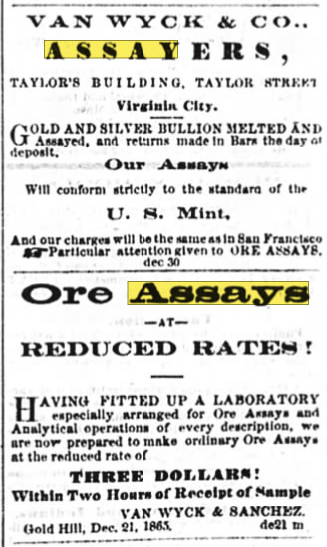
Above is an advertisement for Van Wyck & Co in Virginia City found on Jan 31, 1866 in the Gold Hill Daily News, also referencing Van Wyck & Sanchez – an obscure name that hasn’t previously been reported.
Sidney M. Van Wyck arrived in San Francisco from his home in Baltimore, Maryland sometime before the spring of 1851 as a young child. He brought with him his love of reading. His diary, which still survives, records that he liked to read when business was slow, noting “I have been sitting all today upon a pile of boxes before my door, reading a novel whilst waiting for purchasers. The boys laugh at me as they see me perched up on tobacco boxes, and reading as if I cared for nothing else. ” In July, 1860 Van Wyck was working as a laborer in a gold refinery in San Francisco. Three years later. Van Wyck was in partnership with a Mr. Winchester in Aurora, California and in 1864 Van Wyck was running an assaying business in that town. By the summer of the following year he had moved to Virginia City, Nevada where he advertised that his assays would conform to the U. S. Mint standard and that his charges would be the same as in San Francisco. The following year. Van Wyck opened an office in Gold Hill, Nevada with a Mr. Sanchez. In 1866, Van Wyck & Co. relocated their business to Gold Hill. It is recorded that in just two days in late November, 1866 Van Wyck & Co. melted and assayed over 14,000 ounces of bullion. Late in 1867, Sidney Van Wyck is listed living on Leavenworth Street in San Francisco, and by the spring of 1868 he had sold his assaying business to E.Ruhling & Co. of Gold Hill. However, Van Wyck resumed his assaying business after moving to Hamilton, Nevada during the summer of 1869, taking over the business of Theall & Co. of that city. The 1870 census lists Van Wyck’s age as 39. He was still in business as an assayer in Hamilton in 1873. Van Wyck died on April 27, 1887 in San Francisco.
The cataloguer acknowledges the kind assistance of Dan Owens, author of the soon-to-be published encyclopedia of California coiners and assayers. Hamilton, Nevada was the scene of one of the richest silver discoveries in American history. Legend has it that a blacksmith named Leathers discovered an Indian rummaging through his supplies one night, and chased him off. The following evening, the Indian returned, bearing a lump of silver ore as a peace offering. Leathers and two friends persuaded the Indian to show them where he had found the ore, and on locating it named their find the “Hidden Treasure” mine. The ore found in and around Hamilton was naturally very rich, some assaying at $3,200 per ton, with a 72% silver concentration. The interesting feature about the mines in the area of Hamilton was that they were all shallow, for the silver ore was located within a depth of about 30 feet. Any deeper, and little or no silver ore was to be found. The town of Hamilton was laid out in May of 1868, its first timber structure being the King and Ivers saloon. By the fall of 1869 Hamilton had a population of 10,000, one of one of whom was Sidney Van Wyck. In June, 1873 a Hamilton tobacco merchant set fire to his store to claim the insurance on it. To make sure that his store would not be saved by one of Hamilton’s three fire companies, the merchant shut off the water supply to the whole town. By the end of the day, all but a small portion of Hamilton had burned to the ground (unfortunately for the town s schoolchildren, the brick schoolhouse survived the fire).
The ruins of Hamilton can still be seen, including the Withington Hotel and Wells, Fargo & Company’s offices, both of which were built in 1869. The town was last inhabited in March, 1931.
4.95 oz Van Wyck & Company. Virginia City, Nevada. Silver assay ingot, no. 3051.
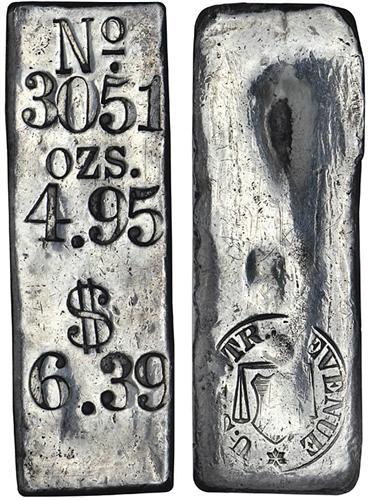
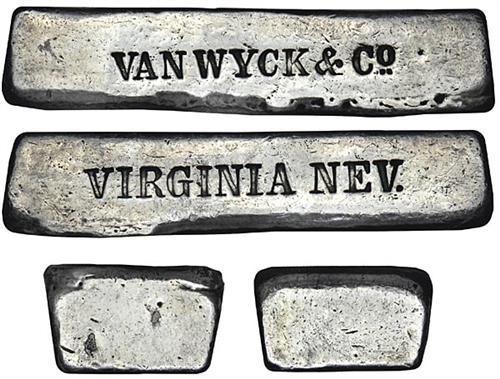
Overall appearance of Very Fine. Not a terribly well made ingot, the faces polished but the edges not squared off, particularly those on the bottom. Ethnic, location, No. and ozs. in logotype, numerals by individual punches. The bar is silver in color and Van Wyck seems to have expected his customer to assume the bar was pure silver since there are no indications anywhere of its metallic content. This is another unusual bar that only goes to show that there were no hard and fast rules about what an assayer had to mark on his bars in the 1860s and 1870s. Judging by the presence of the OIR stamp on this bar and the ad hoc tax paid stamp on the Van Wyck & Co. bar numbered 761 offered in Stack’s January 2002 auction, the present bar was made after the latter yet it looks much cruder and lacks the data the earlier bar carried. Comparison of punches on the two bars suggests that the No., $, and ozs. punches are identical. The ethnic and location stamps are not.
- Face: No. / 3051 / OZS. / 4.95 / $ / 6.39.
- Back: OIR stamp.
- Top side: blank.
- Bottom side: blank.
- Left side: VAN WYCK & Co.
- Right side: VIRGINIA NEV.
- Dimensions: 59.1 x 22.2 x 12.3 mm.
- Current weight: 155.2 gms.
From the John J. Ford, Jr. Collection
Provenance: Mr. Ford’s informational card notes that he received Polaroid photos of this ingot (that also accompany the lot) from Fred Werner on January 25, 1978. Werner had traded Japanese coins for the ingot with Ron Gillio at the ANA Mid-Year convention in Colorado Springs in February, 1978. Werner consigned the ingot to NASCA’s Allen Scott sale (April 28, 1980, lot 2444) from which Mr. Ford bought it for $3,360.
[10/2007] https://auctions.stacksbowers.com/lots/view/3-AV6QR/van-wyck-company-virginia-city-nevada-silver-assay-ingot-no-3051 ($17,250)
[04/1980] https://nnp.wustl.edu/library/auctionlots?AucCoId=511370&AuctionId=521430
14.40 oz UNIQUE $20.21 VAN WYCK & Co. UNPARTED ASSAY BAR
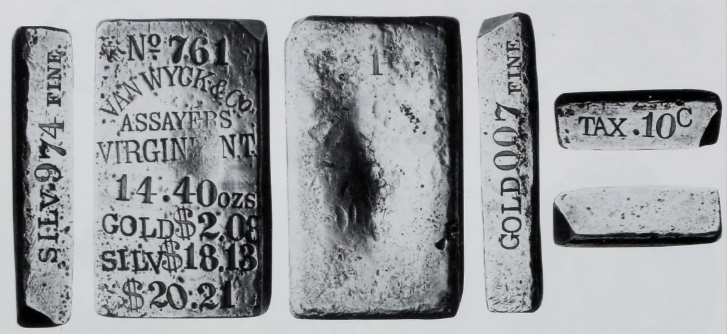
Silver ingot made by the Virginia City, Nevada Territory assaying firm of Van Wyck & Co., undated (after June 30, 1864, before May 3, 1865). No. 761. $20.21. 14.40 ozs. Gold $2.08. Silver $18.13. 74.4×42.3xl4.4mm. rectangular in appearance, trapezoidal in cross-section. Essentially, as made, a few light marks acquired over the years, none important.
- Front: No. 761 [preceding by individual punches] VAN WYCK & Co. ASSAYERS WRGINIA N.T. [preceding in logotype] 14.40 OZS GOLD $2.08 SILV $18.13 $20.21 [preceding by individual punches].
- Left Edge: SILV 974 FINE.
- Right Edge: GOLD 007 FINE.
- Top Edge: TAX. 10c.
- Bottom Edge: blank.
- Back: 1. Upper right and lower left corners clipped for assay, as expected. Neither marked.
This Van Wyck & Company bar is a recent discovery. It first appeared to the numismatic public at the 1998 ANA convention, having been acquired in the Spring of that year from a San Francisco professional. It was first published in the 1999 American Journal of Numismatics and is the plate bar in Dan Owens’ landmark 2000 California Coiners and Assayers. This is its first auction appearance and the first opportunity a wider audience will have to appreciate and bid on this important numismatic find. (SEE COLOR PLATE)
[01/2003] https://archive.org/details/americanacolonia2003stac/page/138/
4.35 oz VANWYCK & Co – Hamilton – No 451, 990 Fine, Face Value: $5.56
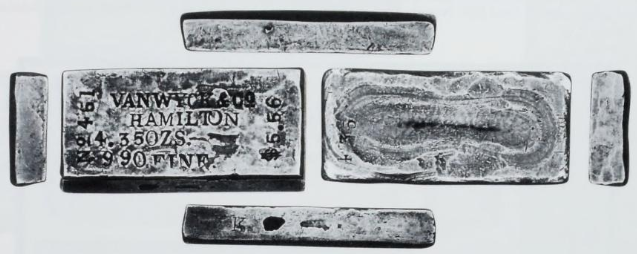
Apparently the only surviving VanWyck & Co ingot from Hamilton County, Nevada. Monetized silver ingot with face value of $5.56. Beige complexion with grey undertones.
Undated [1869-1873] silver ingot made by the Hamilton, Nevada assaying firm of Van Wyck & Co. No. 451.
Rectangular in appearance, trapezoidal in cross-section. Essentially, as made. ViW WCK & Co., OZS., FINE, and No. m logotype punches; HAMILTON, the deposit number (451), weight, fineness, and doU^ value in individual numeral punches. Long edge at top blank, long edge at bottom with a faintly impressed [WC]K. Both short edges blank. Bottom face stamped faintly 435 along right edge. All edges carefully beveled alter manufacture, to make a more presentable looking product. This is a newly discovered Van Wyck and Co. ingot which was consigned to Stack’s after its owner had learned of our interest in ingots through stories in the coin newspapers. More importantly, this is the first ingot we have records of that was made by Van Wyck & Co while the firm was located in Hamilton, Nevada.
[01/2000] https://nnp.wustl.edu/library/auctionlots?AucCoId=3&AuctionId=516740
